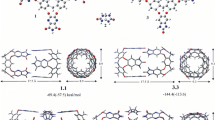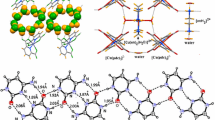Abstract
Self-assembled heterodimeric molecular capsule based on the charged hydrogen bonding interaction between two different CTV monomers (1 and 2) was developed. The formation of the molecular capsule was confirmed by inclusion phenomena of complementary neutral guests in DMSO-d 6. The encapsulated TMS was released by prolonged heating or pH adjustment. Molecular modeling and intermolecular NOEs suggested the three-dimensional structure of the termolecular inclusion complex.
Access this chapter
Tax calculation will be finalised at checkout
Purchases are for personal use only
Preview
Unable to display preview. Download preview PDF.
Similar content being viewed by others
References and Notes
For an excellent introduction on self-assembling biological systems, see: (a) Lehninger, A. L. (1976) Biochemistry, Worth Publishers, Inc., New York, Chapter 36.
Alberts, B., Bray, D., Lewis, J., Raff, M., Roberts, K., and Watson, J. D. (1989) Molecular Biology of the Cell, Garland Publishing, New York.
Namba, K. and Stubbs, G. (1986) Structure of Tobacco Mosaic Virus at 3.6 Å Resolution: Implications for Assembly, Science, 231, 1401–1406.
Klug, A. (1983) From Macromolecules to Biological Assemblies (Nobel Lecture), Angew. Chem. Int. Ed. Engl. 22, 565–582.
For recent reviews, see: (a) Lehn, J.-M. (1995) Supramolecular Chemistry, VCH, Weinheim
Lindsey, J. S. (1991) Self-Assembly in Synthetic Routes to Molecular Devices Biological Principles and Chemical Perspectives: A Review, New J. Chem. 15, 153–180.
Lawrence, D. S., Jiang, T., and Levett, M. (1995) Self-Assembling Supramolecular Complexes, Chem. Rev. 95, 2229–2260.
Philp, D. and Stoddart, J. F. (1996) Self-Assembly in Natural and Unnatural Systems, Angew. Chem. Int. Ed. Engl. 35, 1154–1196.
Grotzfeld, R. M., Branda, N., and Rebek, J., Jr. (1996) Reversible Encapsulation of Disc-Shaped Guests by a Synthetic, Self-Assembled Host, Science, 271, 487–489.
Meissner, R. S., Rebek, J., Jr., and de Mendoza, J. (1995) Autoencapsulation Through Intermolecular Forces: A Synthetic Self-Assembling Spherical Complex, Science, 270, 1485–1488.
Valdes, C., Spitz, U. P., Kubik, S. W., and Rebek, J., Jr. (1995) Pseudo-Spherical Host Molecules: Synthesis, Dimerization, and Nucleation Effects, Angew. Chem. Int. Ed. Engl. 34, 1885–1887.
Valdes, C., Spitz, U. P., Toledo, L. M., Kubik, S. W., and Rebek, J., Jr. (1995) Synthesis and Self-Assembly of Pseudo-Spherical Homo-and Heterodimeric Capsules, J. Am. Chem. Soc. 117, 12733–12745.
Branda, N., Grotzfeld, R. M., Valdes, C., and Rebek, J., Jr. (1995) Control of Self-Assembly and Reversible Encapsulation of Xenon in a Self-Assembling Dimer by Acid-Base Chemistry, J. Am. Chem. Soc. 117, 85–88.
Branda, N., Wyler, R., and Rebek, J., Jr. (1994) Encapsulation of Methane and Other Small Molecules in a Self-Assembling Superstructure, Science, 263, 1267–1268.
Fujita, M., Ogura, D., Miyazawa, M., Oka, H., Yamaguchi, K., and Ogura, K. (1995) Self-Assembly of ten molecules into nanometre-sized organic host frameworks, Nature, 378, 469–471.
Koh, K., Araki, K., and Shinkai, S. (1994) Self-Assembled Molecular Capsule Based on the Hydrogen-Bonding Interaction between Two Different Calix[4]arenes, Tetrahedron Lett. 35, 8255–8258.
Collet, A. (1987) Cyclotriveratrylenes and Cryptophanes, Tetrahedron, 43, 5725–5759.
Collet, A., Dutasta, J.-P., Lozach, B., and Canceill, J. (1993) Cyclotriveratrylenes and Cryptophanes, in E. Weber (ed.), Topics in Current Chemistry, Springer-Verlag, Berlin, Vol. 165, pp. 103–129.
Bondi, A. (1964) van der Waals Volumes and Radii, J. Phys. Chem. 68, 441–451.
Author information
Authors and Affiliations
Editor information
Editors and Affiliations
Rights and permissions
Copyright information
© 1998 Springer Science+Business Media Dordrecht
About this paper
Cite this paper
Lee, S.B., Hong, JI. (1998). Inclusion of Neutral Guests in a Self-Assembling Superstructure. In: Coleman, A.W. (eds) Molecular Recognition and Inclusion. Springer, Dordrecht. https://doi.org/10.1007/978-94-011-5288-4_68
Download citation
DOI: https://doi.org/10.1007/978-94-011-5288-4_68
Publisher Name: Springer, Dordrecht
Print ISBN: 978-94-010-6226-8
Online ISBN: 978-94-011-5288-4
eBook Packages: Springer Book Archive




